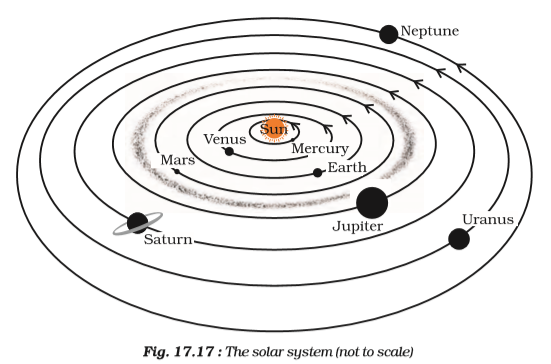Need help? We're here to assist you!
Thank You for Enquiry, we will contact you soon!
Close
The Class 8 is an important year in a student’s life and Science is one of the subjects that require dedication, hard work, and practice. It’s a subject where you can score well if you are well-versed with the concepts, remember the important formulas and solving methods, and have done an ample amount of practice. Worry not! Home Revise is here to make your Class 8 journey even easier. It’s essential for students to have the right study material and notes to prepare for their board examinations, and through Home Revise, you can cover all the fundamental topics in the subject and the complete NCERT Class 8 Science Book syllabus.

Exercise Questions
Choose the correct answer in Questions 1-3.
1. Which of the following is NOT a member of the solar system?
(a) An asteroid
(b) A satellite
(c) A constellation
(d) A comet
Soln:
The answer is (c) A constellation.
Explanation:
A constellation is not a member of the solar system. They are the group of stars that forms a recognisable shape.
2. Which of the following is NOT a planet of the sun?
(a) Sirius
(b) Mercury
(c) Saturn
(d) Earth
Soln:
The answer is (a) Sirius.
Explanation:
Sirius is a star, not a planet of the solar system.
3. Phases of the moon occur because
(a) we can see only that part of the moon which reflects light towards us.
(b) our distance from the moon keeps changing.
(c) the shadow of the Earth covers only a part of the moon’s surface.
(d) the thickness of the moon’s atmosphere is not constant.
Soln:
The answer is (a) we can see only that part of the moon which reflects light towards us.
Explanation:
The moon does not have its own light. It is only seen by us when sunlight falls on the moon and gets reflected towards us. So, we can only see the part of the moon on which the sunlight falls and reflects towards us.
4. Fill in the blanks.
(a) The planet which is farthest from the Sun is ____________ .
(b) The planet which appears reddish in colour is ____________ .
(c) A group of stars that appear to form a pattern in the sky is known as a ____________ .
(d) A celestial body that revolves around a planet is known as __________.
(e) Shooting stars are actually not ____________.
(f) Asteroids are found between the orbits of _________ and _________ .
Soln:
(a) The planet which is farthest from the Sun is Neptune .
(b) The planet which appears reddish in colour is Mars .
(c) A group of stars that appear to form a pattern in the sky is known as a Constellation .
(d) A celestial body that revolves around a planet is known as satellite.
(e) Shooting stars are actually not stars .
(f) Asteroids are found between the orbits of Mars and Jupiter .
5. Mark the following statements as true (T) or false (F).
(a) Pole star is a member of the solar system. ( )
(b) Mercury is the smallest planet of the solar system. ( )
(c) Uranus is the farthest planet in the solar system. ( )
(d) INSAT is an artificial satellite. ( )
(e) There are nine planets in the solar system. ( )
(f) Constellation Orion can be seen only with a telescope. ( )
Soln:
(a) False
Concept Insight: Pole Star is not a member of the Solar System.
(b) True
(c) False
Concept Insight: Neptune is the farthest planet in the solar system.
(d) True
(e) False
Concept Insight: There are eight planets in the Solar System. They are Mercury, Venus, Earth, Mars, Jupiter, Saturn, Uranus and Neptune.
(f) False
Concept Insight: Constellation Orion can be seen during winter around late evenings. It is one of the most magnificent constellations in the sky, visible to the naked eyes.
6. Match items in column A with one or more items in column B.
| A | B |
| (i) Inner planets | (a) Saturn |
| (ii) Outer planets | (b) Pole star |
| (iii) Constellation | (c) Great Bear |
| (iv) Satellite of the Earth | (d) Moon |
| (e) Earth | |
| (f) Orion | |
| (g) Mars |
Soln:
| A | B |
| (i) Inner planets | (g) Mars, (e) Earth |
| (ii) Outer planets | (a) Saturn |
| (iii) Constellation | (c) Great Bear, (f) Orion |
| (iv) Satellite of the Earth | (d) Moon |
7. In which part of the sky can you find Venus if it is visible as an evening star?
Soln:
The planet Venus is found in the western part of the sky after sunset and is said to be known as an evening star.
8. Name the largest planet of the solar system.
Soln:
Jupiter is the largest planet of the solar system.
9. What is a constellation? Name any two constellations.
Soln:
The group of stars that forms a recognisable pattern in the sky is known as a constellation.
Two constellations are Ursa Major and Orion.
10. Draw sketches to show the relative positions of prominent stars in (a) Ursa Major and (b) Orion
Soln:
a) Orion seems to be like a hunter. The three bright stars appear in the belt, while four bright stars are arranged in the form of a quadrilateral.
b) Ursa Major seems to be like a big dipper. There are four stars in the bowl of the dipper and three bright stars in the handle.
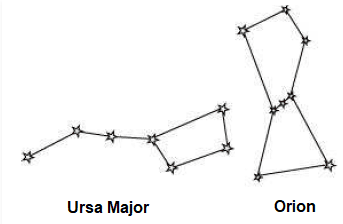
11. Name two objects other than planets which are members of the solar system.
Soln:
a) Meteors
Meteors are small celestial objects that are seen as bright streaks of light in the sky. Due to the heat produced by the friction of the Earth’s atmosphere, the Meteors are burnt out while entering in. This causes the bright streaks in the sky. They are not planets.
b) Asteroids
Asteroids are a collection of a huge number of small objects, gases, and dust revolving around the sun. Between the orbits of Mars and Jupiter, they occupy a large gap. These are not planets; they are celestial bodies.
12. Explain how you can locate the Pole Star with the help of Ursa Major.
Soln:
For locating the pole stars in the sky, first, the big dipper, or the Ursa Major constellation, must be found. The bowl of the big dipper consists of four bright stars.
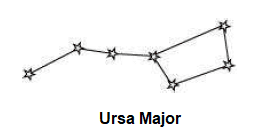
Imagine the two stars at the end of this bowl. Then make an imaginary straight line towards the northern direction connecting these two stars.
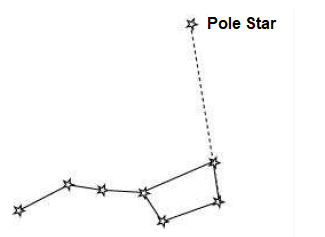
This imaginary line meets the star called the Pole star. The length of the imaginary line from the bowl is about five times the distance between the two stars of the bowl.
13. Do all the stars in the sky move? Explain.
Soln:
No, the earth rotates on its axis from west to east. Therefore, all the stars in the sky (except the pole star) seem to move from east to west. With reference to Earth, the pole star in the sky does not seem to move because it is located above the axis of rotation of the Earth in the north direction. It seems to remain stationary at a point in the sky.
14. Why is the distance between stars expressed in light-years? What do you understand by the statement that a star is eight light-years away from the Earth?
Soln:
The distance between the star from the earth and the distance between the stars is huge. It is troublesome to express this distance in kilometres (km). Therefore, these huge distances are expressed in light-years. One light-year is equal to the distance travelled by light in one single year. One light-year is equal to 9.46 x 1012 km.
The distance of the star from the Earth is eight light years. This means the distance between them is equal to the distance travelled by the light in eight years, i.e., the distance of the star is 8 x (9.6 x 1012 ) = 7.6 x 1013 km away from Earth.
15. The radius of Jupiter is 11 times the radius of the Earth. Calculate the ratio of the volumes of Jupiter and the Earth. How many Earths can Jupiter accommodate?
Soln:
Let us consider Jupiter and Earth are two spheres with radii R and R, ’ respectively. Given in the question that the radius of Jupiter is 11 times the radius of the Earth.
So, R’ = 11R
Volume of the sphere of radius r is given as = 4 ⁄3 πr3
Volume of Earth = 4 ⁄3 πr3
And, volume of Jupiter = π(R1 )3
=4 ⁄3 π(R1 )3 =1331[4/3πR3]
The ratio of the volume of Jupiter and Earth
= Volume of Jupiter volume of Earth =1331(4/3πR3)4/3πR3=1331
Therefore, this ratio suggests that Jupiter can fit 1331 number of Earth in it.
16. Boojho made the following sketch (Fig. 17.29) of the solar system. Is the sketch correct? If not, correct it.
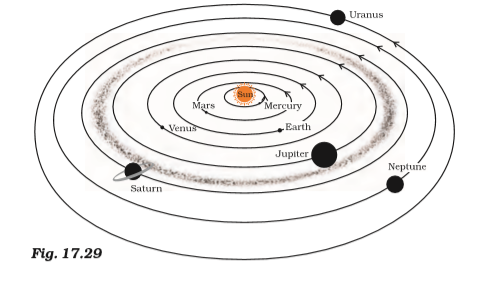
Soln:
No, the diagram made by Boojho is not correct because, in the solar system, the sequence of the planets of their distance from the sun is like Mercury, Venus, Earth, Mars, Jupiter, Saturn, Uranus, and Neptune. Here. he had changed the positions of the planets Venus, Mars, Neptune and Uranus. Besides this, in the diagram, he showed the Asteroids belt between the orbits of Saturn and Jupiter. This is incorrect. The Asteroids belt is located in the middle of the orbits of Jupiter and Mars. The correct diagram of the solar system is given below.
